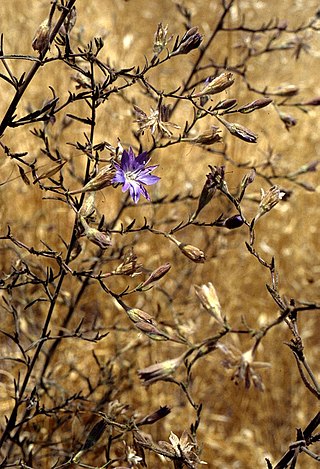Top Qs
Timeline
Chat
Perspective
Malesherbia
Genus of flowering plants From Wikipedia, the free encyclopedia
Remove ads
Malesherbia is a genus of flowering plants consisting of 25 species in the Passifloraceae. This is a xerophytic group endemic to the Peruvian and Chilean deserts and adjacent Argentina. The genus is currently recognized by the APG III system of classification in the family Passifloraceae, and is the sole member of the subfamily Malesherbioideae.[1][2]
Remove ads
Description

Malesherbia is a genus of herbaceous plants and shrubs.
Flower morphology
Members of Malesherbia have perfect hermaphroditic flowers that come in various shades of red, pink, pale yellow, white, and purple.[3] These are tube or funnel shaped, with 10 nerves, 5 sepals, 5 petals, 5 stamen and 3-4 styles.[4] They have either solitary flowers opposite to leaves or inflorescence that look like clusters.[4]
Remove ads
Taxonomy
Summarize
Perspective
In 1794, Hipólito Ruiz López and José Antonio Pavón Jiménez would describe Malesherbia.[5] Malesherbia was distinguished from other genera due to its small five parted limbus, ovulate open jaciniis, five petals that are inserted at the interstices of the throat of the calyx, five oblong and bilocular anthers, three pistils, and several other traits.[5] The genus is named after Chrétien Guillaume de Lamoignon de Malesherbes.[5] In the original description, the type species was not named.
In 1798, Antonio José Cavanilles would describe the genera under Gynopleura. Cavanilles admitted that Malesherbia was described exactly as Gynopleura, however, the seeds of Malesherbia were not described in the original text, and thus Cavanilles felt justified in publishing the genera under Gynopleura.[6] Cacanilles would, however, establish M. tubulosa as the genera's type species.
Accepted species
Source:[7]
- Malesherbia angustisecta Harms
- Malesherbia ardens J.F.Macbr.
- Malesherbia arequipensis Ricardi
- Malesherbia auristipulata Ricardi
- Malesherbia bracteata Phil.
- Malesherbia corallina Muñoz-Schick & R.Pinto
- Malesherbia densiflora Phil.
- Malesherbia deserticola Phil.
- Malesherbia fasciculata D.Don
- Malesherbia fatimae Weigend & H.Beltrán
- Malesherbia haemantha Harms
- Malesherbia humilis Poepp.
- Malesherbia lactea Phil.
- Malesherbia laraosensis H.Beltrán & Weigend
- Malesherbia linearifolia (Cav.) Poir.
- Malesherbia lirana Gay
- Malesherbia paniculata D.Don
- Malesherbia scarlatiflora Gilg
- Malesherbia solanoides Meyen
- Malesherbia splendens Ricardi
- Malesherbia tenuifolia D.Don
- Malesherbia tocopillana Ricardi
- Malesherbia tubulosa (Cav.) J.St.-Hil.
- Malesherbia turbinea J.F.Macbr.
- Malesherbia weberbaueri Gilg
Phylogeny
Source:[8]
| |||||||||||||||||||||||||||||||||||||
Please note, this phylogeny does not include Malesherbia laraosensis. As of 2022, a phylogenetic analysis including M. laraosensis has not been published.
Remove ads
Uses
Medicinal
Malesherbia ardens is used in traditional medicine to treat colds, coughs, bronchitis, and asthma.[9] The entire plant along with Contilo, Arabisca, and Huamanripa are brewed into a tea, which is consumed three times a day.[9]
Distribution
Members of Malesherbia are native to South America, specifically the arid and Andean regions of Perú, Chile and Argentina.[10][11]
References
Wikiwand - on
Seamless Wikipedia browsing. On steroids.
Remove ads


